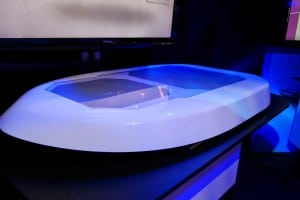Latest News
[Via Satellite 10-08-2014] Boeing Network and Space Systems (N&SS) and Panasonic Avionics have partnered to develop a broadband, electronically steered phased array antenna for commercial airliners. The antenna will deliver in-flight Wi-Fi through Panasonic’s eXconnect broadband service while reducing fuel burn and emissions through a reported 65 percent reduction in weight compared to mechanically steered equivalents.
The antenna, which will be available to the commercial market in 2016, will support data and multicast TV services on Ku-band to deliver In-Flight Connectivity (IFC) to passengers. Paul Geery, vice president of C3 Solutions for Boeing N&SS said the company is offering its Ku-band design to Panasonic as the only licensee of the Boeing technology, to manufacture the antenna system under the pending agreement.
While commercial buyers will see the technology in two years, a version of the antenna has already been in production with Boeing for several years in the military market where buyers are willing to “spare no expense,” according to Todd Hill, director of global communications services, products and capacity at Panasonic Avionics. Now, however, with advancing technology, the low-profile, electronically steered antenna has become affordable enough to bring to the table for commercial customers.
“Our connectivity customers have always wanted an antenna like this but the cost was always too high,” Hill said. “Now, however, technology advancements in the level of integration of digital and analog RF circuits supports an affordable and reliable version.”
The initial focus of the antennas will be for popular narrow-body airframes, such as the 737 and the A320, and, based on demand, the companies plan to offer the technology for a much broader range of narrow- and wide-body aircraft in the future. The antenna mount is also compatible with the ARINC 791 standard, which will allow it to be “installed by the [Original Equipment Manufacturers] OEMs and also retrofit in a robust installation that can be easily maintained over the life of the plane,” Hill said.
According to Geery, once the agreement is finalized, the two companies will complete detailed designs, pre-production units, qualification and certification for the antenna. Last year, Boeing entered into an agreement with Panasonic to provide eXConnect IFC to military customers. Geery confirmed that Boeing would also offer access to IFC through the new low-profile antenna to government customers who used the phased array technology in the past.
While the companies plan to make the technology available and fitted for as many operators as possible, it might not be for everybody. Because the satellites that Panasonic eXconnect is working with are located around the equator, Hill notes that not all operators and air routes are suitable.
“Low-profile antennas are somewhat limited in how close to the horizon they can look, so they are not the best choice for planes that fly a lot of polar routes. The airline’s route structure will determine if the antenna is a good fit for their wide-body fleet,” Hill said, noting that airlines with a route structure based closer to the equator and outside the Arctic Circle are the ideal candidates.
Geery also acknowledged that the phased array antenna would have less coverage in high altitude regions compared to mechanically steered alternatives. Still, Boeing and Panasonic anticipate the pros of an electronically steered antenna will outweigh the cons.
“This should not impact the majority of the routes flown by customers in the target aircraft market,” Geery added.
Despite the geographic limitation in access, Panasonic covers more than 99 percent of air routes globally. Rather than focus extensively on the less than one percent of routes lacking coverage, the company plans to bolster the amount of capacity available over highly trafficked areas. Panasonic has already purchased capacity on the upcoming EpicNG High Throughput Satellite (HTS) Intelsat 29e, which will cover most of the Americas, Europe and the North Atlantic flight corridor. Following the launch of the IS-29 satellite in 2015, Panasonic will have two more HTS payloads coming online in 2016: one aboard Eutelsat 172b and other on IS-33. Eligible operators will benefit from the reduced operational weight and drag. According to Hill, the typical 737 operator will save more than $65,000 annually at current fuel prices.
Panasonic is evaluating whether the antenna system will be available to other service providers once completed, or if it will remain exclusively within the company — similar to Gogo’s agreement with ThinKom. Hill notes that Boeing’s expertise in phased-array antennas is what makes this technology possible. “They’re the only ones we know of that are building phased array antennas. Including antennas for submarines and Air Force One — and those are just the ones that are somewhat public. Who knows what they’ve been building for all the black projects,” he said.
Get the latest Via Satellite news!
Subscribe Now